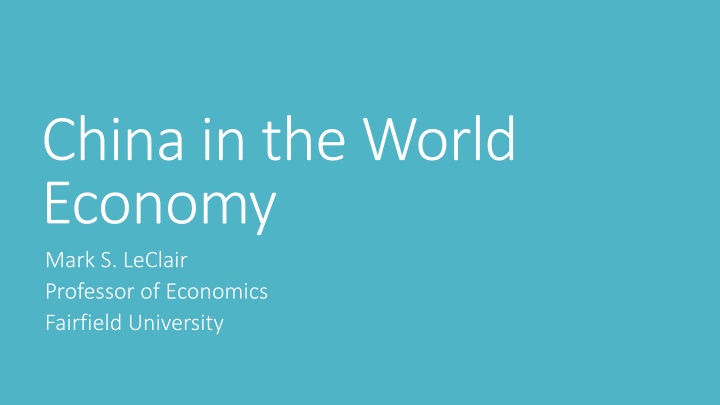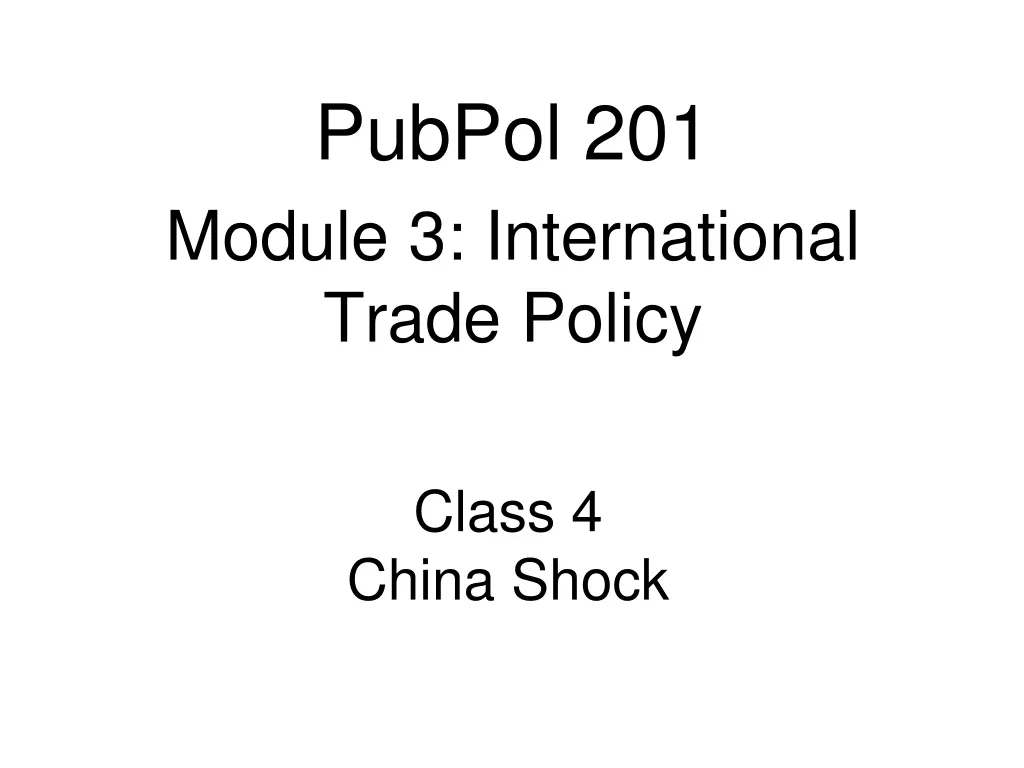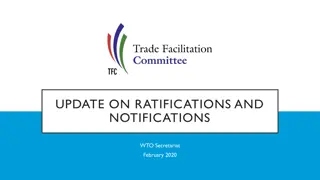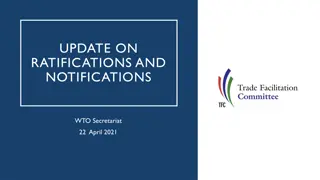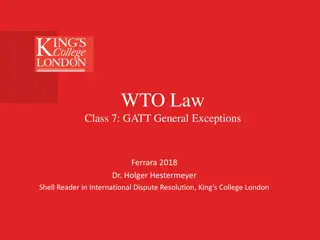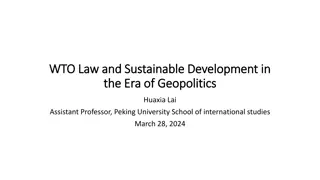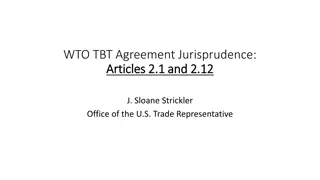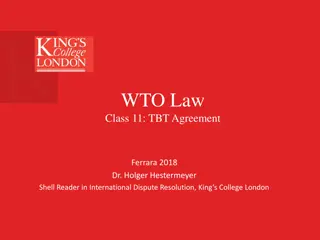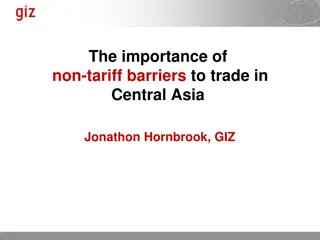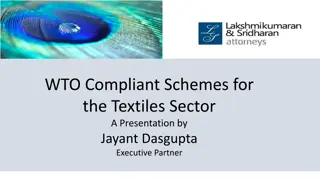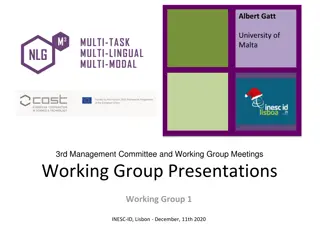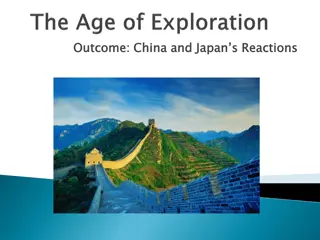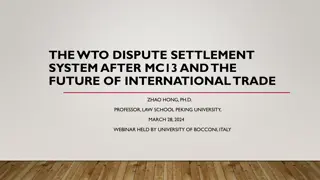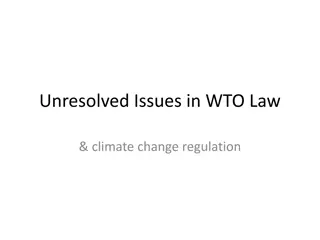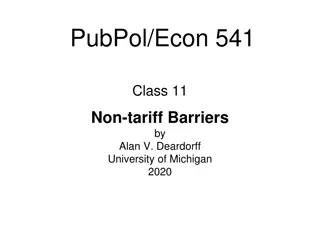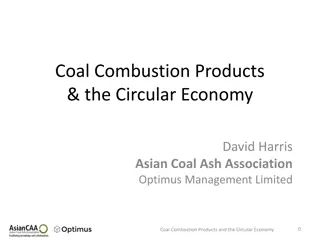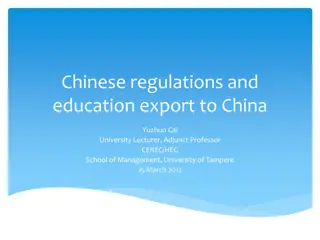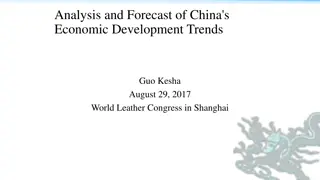China in the World Economy: A Historical Overview and the Importance of GATT/WTO
Explore the evolution of China's economy from its period of isolation to becoming a pivotal player in the global trading system. Delve into key events such as Deng Xiaoping's economic reforms and China's admission to the GATT/WTO. Understand the significance of the GATT system and how it shaped international trade policies.
Download Presentation

Please find below an Image/Link to download the presentation.
The content on the website is provided AS IS for your information and personal use only. It may not be sold, licensed, or shared on other websites without obtaining consent from the author.If you encounter any issues during the download, it is possible that the publisher has removed the file from their server.
You are allowed to download the files provided on this website for personal or commercial use, subject to the condition that they are used lawfully. All files are the property of their respective owners.
The content on the website is provided AS IS for your information and personal use only. It may not be sold, licensed, or shared on other websites without obtaining consent from the author.
E N D
Presentation Transcript
China in the World Economy Mark S. LeClair Professor of Economics Fairfield University
To Obtain Slides.. Go to www.faculty.Fairfield.edu/mleclair Look for LLL link at top of page. Click and document will open
5 Days of Presentations 5 Days of Presentations China s economy and its entry into the world trading China s economy and its entry into the world trading system system How important is China in the world economy How important is China in the world economy Why the conflict between the U.S. and China? Why the conflict between the U.S. and China? Geopolitical and Trade issues Geopolitical and Trade issues Forming a new relationship Forming a new relationship
A Brief History A Brief History China largely closed to the world until period of the Republic -1912 onwards (end of Qing Dynasty) Adopted Western form of government and opened to the outside world Lasted until 1949, with the ascension of Communism Country quickly closed to rest of world, including Russia in 1958 (Great Leap Forward)
Isolation Continued until Nixons Trip in Isolation Continued until Nixon s Trip in 1972 1972 Social disruptions continued with the Cultural Revolution Social disruptions continued with the Cultural Revolution Country remained closed, with little external trade Country remained closed, with little external trade Deng Xiaoping (1980s) began the process of putting aside ideology for practical policies of growth and trade aside ideology for practical policies of growth and trade By 1990s, seeking entrance into GATT/WTO By 1990s, seeking entrance into GATT/WTO 1994, China is admitted 1994, China is admitted Deng Xiaoping (1980s) began the process of putting
Basics of WTO/GATT System and Why it Basics of WTO/GATT System and Why it Matters .. Matters .. General Agreement on Tariffs and Trade (GATT) dates to General Agreement on Tariffs and Trade (GATT) dates to 1947 1947 First attempt at multilateralism First attempt at multilateralism all tariff reductions became universal became universal As long as nation had Most Favored Nation (MFN) status As long as nation had Most Favored Nation (MFN) status Initially a club for the industrialized nations Initially a club for the industrialized nations all tariff reductions
Results of the GATT Process Results of the GATT Process Tariffs came down dramatically from their post-war levels International trade boomed Currently, the average U.S. tariff rate is around 2% - Both Europe and Japan have similar rates Always some exceptions on specific products, but overall rates are low
Problem Built into System Problem Built into System Everyone got same tariff rates, but nothing was said Everyone got same tariff rates, but nothing was said about the about the level level of those rates of those rates Developing nations accepted tariff cuts from developed Developing nations accepted tariff cuts from developed nations without cutting their own nations without cutting their own By 1990s, huge disparity between rates impacting By 1990s, huge disparity between rates impacting imports into developed nations versus those into imports into developed nations versus those into developing nations developing nations This is one reason why trade relations with China are strained This is one reason why trade relations with China are strained
To China. To China . China admitted to WTO in 1994 China admitted to WTO in 1994 Created 7 export processing zones Created 7 export processing zones Enormous movement of people to these cities began Enormous movement of people to these cities began Millions left subsistence farming to engage with international Millions left subsistence farming to engage with international trade trade Exports and growth boomed Exports and growth boomed China s internal consumer market is still small in relation to its China s internal consumer market is still small in relation to its economic size economic size
Gross Domestic Product Gross Domestic Product
Exports Exports
Dramatic Growth not seen Anywhere Before Dramatic Growth not seen Anywhere Before 10% range until about 4 years ago, 6% range now 10% range until about 4 years ago, 6% range now Economy will double in size every 12 years Economy will double in size every 12 years Reflection of a vibrant people who had been held Reflection of a vibrant people who had been held down by their government down by their government
Comparing the U.S. and China Comparing the U.S. and China GDP per capita much higher in the US GDP per capita much higher in the US China still ranks far behind many industrialized China still ranks far behind many industrialized countries and even some developing countries countries and even some developing countries Figures (per Capita GDP) Figures (per Capita GDP) U.S. $59,495 U.S. $59,495 Belgium: $46,301 Belgium: $46,301 Costa Rica: $17,149 Costa Rica: $17,149 Chile: $24,588 Chile: $24,588 China: $16,624 China: $16,624
Problem for the Government Problem for the Government Model is based upon continued expansion of economy Model is based upon continued expansion of economy If growth drops to 3% range, problems start If growth drops to 3% range, problems start Massive external debt from capital inflows Massive external debt from capital inflows Inability to raise standard of living of Chinese who moved later in Inability to raise standard of living of Chinese who moved later in the process (unrest?) the process (unrest?) Inability to develop a stron Inability to develop a strong enough consumer class to make up g enough consumer class to make up for declining external trade for declining external trade As standard of living rises, competitiveness will fall (India waits As standard of living rises, competitiveness will fall (India waits in the queue) in the queue)
Tension in Chinese Development Model Tension in Chinese Development Model Promise of higher standard of living creates contract Promise of higher standard of living creates contract between government and people between government and people Slow down in growth cannot be allowed to happen, as that Slow down in growth cannot be allowed to happen, as that breaks the contract breaks the contract Social tensions are already high in parts of the country Social tensions are already high in parts of the country Result: Chinese government undertakes development Result: Chinese government undertakes development projects that make little or no sense projects that make little or no sense Building of cities where no one lives Building of cities where no one lives
Reminds one of Reminds one of Keyne s workers do dig holes and others to fill them in workers do dig holes and others to fill them in Problem is that it creates permanent overhang in real Problem is that it creates permanent overhang in real estate estate Why build new apartments, when you have whole cities Why build new apartments, when you have whole cities that are empty? that are empty? Same with infrastructure spending Same with infrastructure spending Keyne s comment: I don t care if you pay comment: I don t care if you pay
Other Tensions in the Chinese Development Model Ignored pollution until now Ignored pollution until now In Beijing, air quality alerts are frequent In Beijing, air quality alerts are frequent it is common for schools to be closed as a result for schools to be closed as a result Although situation improving, WHO ranks air as worst in world Although situation improving, WHO ranks air as worst in world Rivers are badly polluted Rivers are badly polluted Plus all problems associated with mass migration Plus all problems associated with mass migration Trade tensions are building quickly with U.S. Trade tensions are building quickly with U.S. it is common
Is Chinese Development Simply a Redo of Is Chinese Development Simply a Redo of the Japanese Situation? the Japanese Situation? Very rapid growth until wage growth ended competitiveness India is waiting in the wings Most important difference-Japan never had unlimited labor
Week 2 Week 2 China s Importance in World China s Importance in World Economy Economy Until 15 years ago, China s GDP made little difference in Until 15 years ago, China s GDP made little difference in total world output total world output Likewise, not a major player in international trade Likewise, not a major player in international trade U.S. debates on trade imbalances were about Japan and OPEC U.S. debates on trade imbalances were about Japan and OPEC China is now world s second largest economy and largest China is now world s second largest economy and largest exporter exporter
Some Context about the U.S. Role in Some Context about the U.S. Role in World Trade World Trade The U.S. is The U.S. is by international standard by international standard a closed economy Imports represent about 17% of Gross Domestic Product Imports represent about 17% of Gross Domestic Product High as 50% in many European economies High as 50% in many European economies Produce our own energy, raw materials, housing, food, cars, etc. Produce our own energy, raw materials, housing, food, cars, etc. Figures indicate we import mostly low Figures indicate we import mostly low- -end manufactures (textiles, clothing) and electronic goods clothing) and electronic goods Plus, capital goods, although we are also a major exporter in that Plus, capital goods, although we are also a major exporter in that category category a closed economy end manufactures (textiles,
Our massive trade deficit with China ($350B) is particularly Our massive trade deficit with China ($350B) is particularly distressing in that context distressing in that context Take China out of the picture, and U.S. trade is largely balanced Take China out of the picture, and U.S. trade is largely balanced U.S. Exports were $187.5 billion; imports were $522.9 billion U.S. Exports were $187.5 billion; imports were $522.9 billion What Trump s aggressive stance against China is showing is What Trump s aggressive stance against China is showing is that unequal trade relationships leave both parties vulnerable that unequal trade relationships leave both parties vulnerable China cannot really punish us for our tariffs, since they import so China cannot really punish us for our tariffs, since they import so little from the U.S. little from the U.S.
The Chinese Economy in Figures The Chinese Economy in Figures GDP GDP $12.2 Trillion, second only to the U.S. $12.2 Trillion, second only to the U.S. Note the anomaly in terms of standard of living . Note the anomaly in terms of standard of living . GDP is 60% that of the U.S., but the population is 4X as large GDP is 60% that of the U.S., but the population is 4X as large Standard of living is about 1/6 that of U.S. Standard of living is about 1/6 that of U.S. Growth rate in China is about 6% now, versus our recent return to 4% Growth rate in China is about 6% now, versus our recent return to 4% growth growth Will continue to catch up to the U.S., although much more slowly Will continue to catch up to the U.S., although much more slowly And, similar growth rates in other regions didn t last (LA in 1960s) And, similar growth rates in other regions didn t last (LA in 1960s)
Exports Exports 2.174 Trillion, with a trade (CA) surplus of only $59 billion 2.174 Trillion, with a trade (CA) surplus of only $59 billion Runs deficits with other countries Runs deficits with other countries Also noted in balance of payments figures is the presence Also noted in balance of payments figures is the presence of over $17 trillion in foreign debt (capital inflows) of over $17 trillion in foreign debt (capital inflows) Represents danger in the future, if capital decides the good Represents danger in the future, if capital decides the good times are over times are over
Importance to World Trade Importance to World Trade Total World Trade in 2017 $11.9 Trillion So China responsible for about a 1/6thof that Most important exports
1. 1.Electrical machinery, equipment: US$599 billion (26.4% of total exports) Electrical machinery, equipment: US$599 billion (26.4% of total exports) 2. 2.Machinery including computers: $382.9 billion (16.9%) Machinery including computers: $382.9 billion (16.9%) 3. 3.Furniture, bedding, lighting, signs, prefab buildings: $89.8 billion (4%) Furniture, bedding, lighting, signs, prefab buildings: $89.8 billion (4%) 4. 4.Clothing, accessories (not knit or crochet): $73.6 billion (3.2%) Clothing, accessories (not knit or crochet): $73.6 billion (3.2%) 5. 5.Knit or crochet clothing, accessories: $72 billion (3.2%) Knit or crochet clothing, accessories: $72 billion (3.2%) 6. 6.Optical, technical, medical apparatus: $70.6 billion (3.1%) Optical, technical, medical apparatus: $70.6 billion (3.1%) 7. 7.Plastics, plastic articles: $70.6 billion (3.1%) Plastics, plastic articles: $70.6 billion (3.1%) 8. 8.Vehicles: $67.4 billion (3%) Vehicles: $67.4 billion (3%) 9. 9.Articles of iron or steel: $57.3 billion (2.5%) Articles of iron or steel: $57.3 billion (2.5%) 10. 10.Toys, games: $55.3 billion (2.4%) Toys, games: $55.3 billion (2.4%)
Some Things to Note Top two items are high Top two items are high- -end manufactured goods end manufactured goods Then, furniture, clothing Then, furniture, clothing These latter products are highly vulnerable to producers in These latter products are highly vulnerable to producers in other developing countries (e.g. India) other developing countries (e.g. India) China should assume these markets will be captured by other China should assume these markets will be captured by other nations in the future nations in the future Nation remains only a small exporter of goods such as cars Nation remains only a small exporter of goods such as cars
What does China Import? What does China Import? Surprisingly, some primary imports are in the same Surprisingly, some primary imports are in the same category as exports (e.g. machinery) category as exports (e.g. machinery) Mixed in are large imports of raw materials Mixed in are large imports of raw materials petroleum, copper, other ores copper, other ores Reflection of China s major role as a manufacturing nation Reflection of China s major role as a manufacturing nation petroleum,
Electrical machinery, equipment: US$455.5 billion (24.7% of total Chinese Electrical machinery, equipment: US$455.5 billion (24.7% of total Chinese imports) imports) Mineral fuels including oil: $247.6 billion (13.4%) Mineral fuels including oil: $247.6 billion (13.4%) Machinery including computers: $169.8 billion (9.2%) Machinery including computers: $169.8 billion (9.2%) Ores, slag, ash: $125.4 billion (6.8%) Ores, slag, ash: $125.4 billion (6.8%) Optical, technical, medical apparatus: $97.4 billion (5.3%) Optical, technical, medical apparatus: $97.4 billion (5.3%) Vehicles: $79.2 billion (4.3%) Vehicles: $79.2 billion (4.3%) Plastics, plastic articles: $68.9 billion (3.7%) Plastics, plastic articles: $68.9 billion (3.7%) Organic chemicals: $55.8 billion (3%) Organic chemicals: $55.8 billion (3%) Oil seeds: $44.5 billion (2.4%) Oil seeds: $44.5 billion (2.4%) Copper: $41.2 billion (2.2%) Copper: $41.2 billion (2.2%)
Some of the Trade Issues are a Reflection of Chinas Some of the Trade Issues are a Reflection of China s Dependence on Commodity Imports (particularly oil) Dependence on Commodity Imports (particularly oil) Heavy imports of energy ($250 billion) have to be paid for Heavy imports of energy ($250 billion) have to be paid for China runs a surplus with us to pay for its energy deficit China runs a surplus with us to pay for its energy deficit No medium No medium- -term solution to this problem term solution to this problem In an effort to curb pollution and fix the trade issue, China has In an effort to curb pollution and fix the trade issue, China has invested heavily in renewables invested heavily in renewables Note that coal still is China s primary energy source Note that coal still is China s primary energy source Grid stability is at risk if solar and wind further expanded Grid stability is at risk if solar and wind further expanded
Possible Strategy Possible Strategy Begin to develop a more vibrant consumer society Begin to develop a more vibrant consumer society Future demand may have to come internally Future demand may have to come internally Domestic savings rate very high (number difficult to pin down) Domestic savings rate very high (number difficult to pin down) But, will not stay high forever But, will not stay high forever
Who Buys Chinas Exports? Who Buys China s Exports?
For China, Dangerous Dependence on For China, Dangerous Dependence on U.S. Market U.S. Market As geopolitical changes have worsened U.S./Chinese As geopolitical changes have worsened U.S./Chinese relations, major disruptions may occur relations, major disruptions may occur China s decision to occupy parts of the South China Sea probably China s decision to occupy parts of the South China Sea probably not a good move not a good move U.S. trade far more important than the potential for finding oil in U.S. trade far more important than the potential for finding oil in the region the region Given who is in the White House right now, could be the Given who is in the White House right now, could be the biggest strategic mistake China has made since entering the biggest strategic mistake China has made since entering the world trading system world trading system
Like all Developing Nations that Undergo Like all Developing Nations that Undergo Rapid Growth Rapid Growth Competitiveness declining Competitiveness declining Wages growing at 11% annual rate (doubling in 6.5 years) Wages growing at 11% annual rate (doubling in 6.5 years) Wages in India now significantly lower, and shifting production of Wages in India now significantly lower, and shifting production of textiles, furniture, apparel, etc. in that direction is simple textiles, furniture, apparel, etc. in that direction is simple Same story as with Japan (in 1980s) Same story as with Japan (in 1980s) supposed to take over the world economy the world economy Growth petered out in the late eighties and Japan went into Growth petered out in the late eighties and Japan went into permanent slow growth permanent slow growth supposed to take over
Finally, Chinese Yuan ( Finally, Chinese Yuan (Remnibi Remnibi) ) Nation of China s size and importance would be expected Nation of China s size and importance would be expected to have a reserve currency to have a reserve currency IMF has labeled the Yuan as a reserve currency IMF has labeled the Yuan as a reserve currency But, it doesn t look like a reserve currency But, it doesn t look like a reserve currency It is pegged to a basket (of something) It is pegged to a basket (of something) It is not used for international transactions, like the dollar or euro It is not used for international transactions, like the dollar or euro is is It is significantly It is significantly mis mis- -valued valued
Reflection of Chinas Odd Place in the Reflection of China s Odd Place in the World World It is both a dominant, modern economy and an emerging It is both a dominant, modern economy and an emerging developing economy developing economy Problem Problem Cannot claim that it is both in international Cannot claim that it is both in international relations relations Trade Problems with U.S. are the kind we would have with Trade Problems with U.S. are the kind we would have with Brazil or Colombia, not with an industrialized nation Brazil or Colombia, not with an industrialized nation
Questions? Questions?
Brexit and the Future of the EU Brexit and the Future of the EU Evolution of EU: Evolution of EU: Free trade area, customs union, common market, currency Free trade area, customs union, common market, currency union (for some), political union union (for some), political union At each stage, autonomy of individual states is reduced At each stage, autonomy of individual states is reduced By final stage, nations within EU are entangled with federal By final stage, nations within EU are entangled with federal law the same way U.S. states are law the same way U.S. states are Also means loss of cultural identity to some degree in each Also means loss of cultural identity to some degree in each nation nation
Pushback.. Pushback .. First evidence of problem was in 2005 First evidence of problem was in 2005 France votes on EU Constitution France votes on EU Constitution Defeated by significant Margin Defeated by significant Margin French were primary drivers of move to EU, so vote left French were primary drivers of move to EU, so vote left many shocked many shocked No further attempts were made to push an EU No further attempts were made to push an EU constitution constitution
What Bothered UK Voters and led to What Bothered UK Voters and led to Brexit Vote Brexit Vote Increasing loss of sovereignty Increasing loss of sovereignty Policies made in Brussels frequently not popular in UK Policies made in Brussels frequently not popular in UK Immigration issue may have been most publicized, but Immigration issue may have been most publicized, but trade restrictions on deals outside EU also a problem trade restrictions on deals outside EU also a problem Energy policies have left grid in UK incapable of Energy policies have left grid in UK incapable of providing sufficient power, particularly during winter providing sufficient power, particularly during winter months (only 4% margin, used to be 17%) months (only 4% margin, used to be 17%) https://www.bbc.com/news/business https://www.bbc.com/news/business- -29794632 29794632
Top Reasons for Brexit Top Reasons for Brexit Loss of Sovereignty Loss of Sovereignty Inability to negotiate trade deals outside EU (e.g. Australia) Inability to negotiate trade deals outside EU (e.g. Australia) Burdensome regulatory environment (plastic forks) Burdensome regulatory environment (plastic forks) Problems arising from introduction of euro Problems arising from introduction of euro EU immigration policies are unsustainable EU immigration policies are unsustainable EU annual contributions are large and could be spent EU annual contributions are large and could be spent elsewhere elsewhere Political elitism Political elitism
What does Brexit look like Right Now? What does Brexit look like Right Now? Unclear at present . Unclear at present . References to Soft Brexit, No Deal Brexit, etc. References to Soft Brexit, No Deal Brexit, etc. Common features: Common features: UK national policies restored on immigration and trade UK national policies restored on immigration and trade Access to EU nations restricted by usual tariff structure (WTO Access to EU nations restricted by usual tariff structure (WTO tariffs will apply) tariffs will apply) UK participation in agricultural policy and regulatory policy UK participation in agricultural policy and regulatory policy will end will end
Fear in Brussels.. Fear in Brussels .. UK is just the beginning UK is just the beginning Hungary, Poland, Croatia are expressing deep misgivings Hungary, Poland, Croatia are expressing deep misgivings about EU Policies about EU Policies Have far less to lose than the UK, so Have far less to lose than the UK, so Polexit quicker and less complicated quicker and less complicated Polexit might be might be
Week 3 Week 3 The Problematic U.S./China The Problematic U.S./China Relationship Relationship As noted, China entered the WTO in 1994 As noted, China entered the WTO in 1994 Major advancement in the nation s reentry into the Major advancement in the nation s reentry into the world political and economic system world political and economic system At the time, the U.S. wanted to ease tensions with China At the time, the U.S. wanted to ease tensions with China and incorporate them into the world trading system and incorporate them into the world trading system conflict far less likely conflict far less likely Assumed democratic institutions would develop Assumed democratic institutions would develop
Problems Problems No experience with democracy, except the short 20+ year period that the Chinese Nationalists were in power Chinese policies are 100% self-interested Doesn t feel any obligation to promote world development or world stability Contrary to the U.S. role (at least until Donald Trump) Conflict of some kind probably inevitable
Current Sources of Tension Between the Current Sources of Tension Between the U.S. and China U.S. and China Obviously, trade, as noted is the biggest sore point Obviously, trade, as noted is the biggest sore point U.S. tolerated restrictive trade policies until now U.S. tolerated restrictive trade policies until now Such as requirement that firm s share technology in order to Such as requirement that firm s share technology in order to export to China export to China Those days are probably over, even after Donald Trump Those days are probably over, even after Donald Trump Manipulation of the Yuan/ Manipulation of the Yuan/Remnibi Remnibi viewed as an unfair trade practice trade practice Not recognized by WTO as such, but should be viewed as an unfair
Geopolitics Geopolitics China s attempted annexation of much of the South China China s attempted annexation of much of the South China Sea Sea Including areas claimed by Malaysia, Indonesia and the Including areas claimed by Malaysia, Indonesia and the Philippines, Vietnam, etc. Philippines, Vietnam, etc. No negotiations, just began building a military base on one of No negotiations, just began building a military base on one of the uninhabited islands the uninhabited islands
